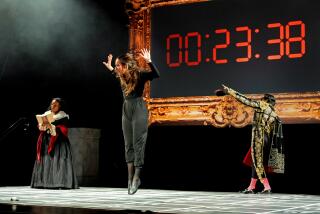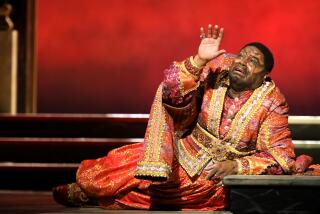Review: Death haunts Frida Kahlo’s long and clumsily winding road to the lyric stage
When Robert Xavier Rodríguez’s “Frida” had its premiere in 1991 at the American Music Theater Festival in Philadelphia, Frida Kahlo was certainly well known, but not the art-world rock star she has become in the quarter century since.
For the hauntingly beautiful Mexican painter, who spent her short adult life entirely in pain after a terrible bus accident that broke her bones and punctured her internal organs, every day was Día de los Muertos, the Day of the Dead. Her morbidity created the exceptional life force apparently read in her mesmerizing eyes and perceptibly evident in her work. If she hadn’t existed, opera would have had to invent her.
Long Beach Opera brought “Frida” to Southern California for the first time Saturday night in an outdoor production in the sculpture garden of the Museum of Latin American Art, and the company will take it to Grand Performances for a free performance in downtown Los Angeles on Friday night. It’s a piece that came along at a time when American opera decided anything goes. “Frida” fit right in.
Rodríguez’s engaging score reflected the Texan composer’s Latin roots, academic training (at USC and as one of the last students of the legendary Nadia Boulanger in Paris) and snappy capacity to channel all manner of American music theater tradition. “Frida” enjoys a healthy helping of Weill, Bernstein and Sondheim, with a little Stravinsky, Wagner and Tchaikovsky gleefully thrown in.
Like a Broadway show or Mozart’s “The Magic Flute,” the opera includes spoken theater and song. The strong book is by the experimental South African feminist playwright and director Hilary Blecher, with characterful monologues and lyrics by Cruz. Blecher directed a striking first production in Philadelphia with a large cast of singers, dancers (vividly choreographed by Hope Clarke) and, significantly, puppets.
For its year-end classical music honors of 1991, the New York Times hailed “Frida” as the “Best Realization of That Clumsy Phrase ‘Opera/Music Theater.’” By now, “Frida” has been staged internationally in 15 cities. Cincinnati Opera mounts another new production this week.
Times have, of course, changed. It might seem like another era entirely when a Southern composer’s opera, with a text influenced by Latin American magical realist literature, came along just as the U.S. was about to elect a Southerner president who spoke of his admiration for magical realist novelist Gabriel García Márquez. We have since had Julie Taymor’s ravishing 2002 biopic, “Frida,” which has pretty much imprinted Salma Hayek and Alfred Molina into the popular imagination as Frida and her husband, flamboyant muralist Diego Rivera.
Moreover, nothing about “Frida” any more seems even faintly clumsy, musically or theatrically. This is the world of opera we know. The week preceding “Frida,” the local premieres of George Lewis’ “Afterword” at the Ojai Music Festival, Lou Harrison’s “Young Caesar” at Walt Disney Concert Hall and Kamal Sankaram’s “Thumbprint” at REDCAT all merged different kinds of music and dramatic devices to find original ways to present come-of-age stories, as “Frida” does.
If anything, “Frida” feels a little old-fashioned in its dramatic approach. It offers a chronological survey of the painter’s life, beginning in 1923 with her as a 16-year-old student in Mexico City. The 13 scenes take her through her first menstruation, her accident, her marriage to Rivera, the 1933 trip to New York City where Rivera creates a scandal by including Lenin in a mural for Rockefeller Center (nothing, unfortunately, of the couple’s earlier trip to California), the psychodrama of Frida’s and Diego’s infidelities and tumultuous relationship, Frida’s affair with Trotsky and photographer Nickolas Muray, Frida’s and Diego’s divorce and then re-marriage, and finally, her blossoming as a painter just as her body gives out at age 44.
It’s all there, neatly and concisely packaged, a whirlwind tour of Kahlo’s life. The musical bits fall in place easily, as well. An instrumental sextet — violin, clarinet, trumpet, percussion, prominent accordion and piano — sound just right, be it one minute Mexican, the next Stravinskian. Catchy licks and hooks come and go like musical flickers. Now and then, when the going gets emotionally tough, Frida and even the less reflective Diego will have a very brief go at a fulsome operatic phrase, but the beat picks up in no time.
So leave it to unconventional Long Beach Opera to supply the lost clumsiness. The company has found in Puerto Rican mezzo-soprano Laura Virella and Venezuelan American baritone Bernardo Bermudez an instantly believable Frida and Diego. Both are capable singers and actors, compelling onstage. They look the part, other than Bermudez not being quite as down to earth as Diego and Virella a little more down to earth than we think of Frida as being.
But Rodríguez doesn’t really allow much room for character development. What drama there is, is more the melodrama of Frida’s and Diego’s relationship and sexual lives.
It is the biographical parade, in all its mysterious, miraculous, macabre, brilliantly colored splendor that matters. And that requires resources, the lack of which LBO artistic and general director Andreas Mitisek makes a concerted effort to disguise in his production. Rather than the original cast of 13 singers and dancers, four overworked singers are here required to take on all the secondary roles and all the movement. No puppets come to their assistance. Amplification is needed for the outdoors, and the instrumental ensemble, which is off to the side and capably conducted by Kristof Van Grysperre, doesn’t have the presence it needs.
The setting, on the other hand, is ideal. You walk through the museum, where there is a fine exhibition of photos of Frida by Muray. Paintings by Kahlo and Rivera are suitably projected behind the sculpture garden stage. Mitesek’s costumes capture the spirit of the couple and the times. In the background are the urban neighborhood street noises — sirens and what could have either been firecrackers or popguns, which add an ineffable tension.
“Frida” ends with the hallucinatory heroine piecing together life as her body falls apart. When the quartet of singer-dancers are not being Henry Ford and his wife, Nelson Rockefeller and his wife, Trotsky and his long suffering wife, Edward G. Robinson or Rivera’s many lovers, they are death, wearing traditional Day of the Dead skull masks. Kahlo’s intimacy with death is what made her so alive, and what kept her going as long as she did, and maybe that has had something to do with keeping Rodríguez’s opera going as long as it improbably has.
♦ ♦ ♦ ♦ ♦ ♦ ♦ ♦ ♦ ♦
‘Frida’
When and where: 8 p.m. Sunday, Saturday and June 25 at the Museum of Latin American Art, 628 Alamitos Ave., Long Beach; and 8 p.m. Friday at Grand Performances, Two California Plaza, downtown Los Angeles
Cost: $49-$150 (MOLAA) and free (Grand Performances)
Info: (562) 470-7464, Ext. 101, www.longbeachopera.org
Running time: 2 hours, 20 minutes (including one intermission)
MORE WEEKEND REVIEWS:
In ‘The Conduct of Life,’ witness an American classic that’s more often taught than staged
Sensuality, brutality, madness: The drama of Eifman Ballet in ‘Red Giselle’
L.A. Master Chorale finds more magic in ‘Lux Aeterna’
American Contemporary Ballet digs back to 1890 with revelatory results
More to Read
The biggest entertainment stories
Get our big stories about Hollywood, film, television, music, arts, culture and more right in your inbox as soon as they publish.
You may occasionally receive promotional content from the Los Angeles Times.







